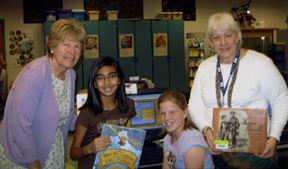|

Virginia McGregor, Students Vanessa and Madeline, and Sherry
Grant pose with biography resources
|
Teacher-librarian Sherry Grant and 5th-grade classroom teacher
Virginia McGregor taught this unit in April and May of 2007 at
Anasazi School in Scottsdale, Arizona. They taught the initial
lesson as a team in the library and taught additional lessons
individually in the library and in the classroom.
They adapted the students' final product. Instead of writing
a summary paragraph, the students used ReadWriteThink.org's
electronic, interactive tool called bio-cube.
|
|
| Internet
Pathfinder: Inventors and Inventions |
Although this pathfinder is not included in the lesson plan in
the book, students and educators can use it as a resource to introduce
this lesson. It can also be used to supplement print information
about kid inventors. If educators expand the inventor and inventions
research to include adult inventors, these Web sites may be particularly
useful.
|
| Alternate
or Additional Product: Rhyming Poem |
Instead of or in addition to writing summaries, use Imaginative
Inventions (rhyming poems) or The Inventor's Times: Real-Life
Stories of 30 Amazing Creations (newspaper articles) as models
for alternate ways to communicate main ideas and supporting details.
|
| Extension:
Telecomputing Project: Kid-made Inventions |
Along with third-grade teacher Jenny Himmelstein, I cotaught
this unit of instruction, including the extension, in 1999 and
2000. This is an example of one team of students' telecomputing
project. They were challenged to make an envelope licker that
did not require using one's tongue. After they created their invention,
they wrote a group summary that included the problem, their solution,
relevant details, and the life skills they used as they pursued
this challenge.
|
AASL Standards
for the 21st-Century Learner:
- Read, view, and listen for information presented in any format
(e.g., textual, visual, media, digital) in order to make inferences
and gather meaning. (1.1.6)
- Organize knowledge so it is useful. (2.1.2)
- Assess the quality and effectiveness of the learning product.
(3.4.2)
|